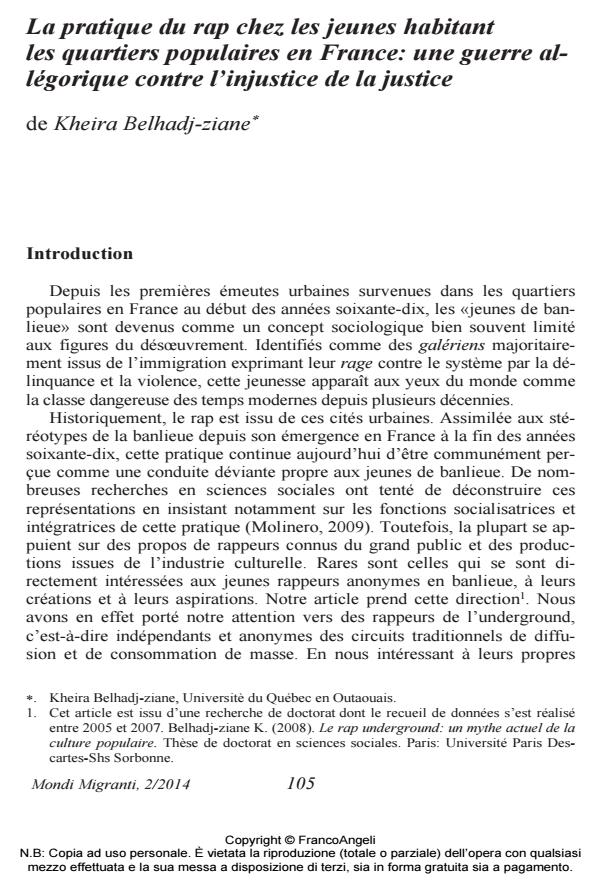The rap music among youth living in poor neighborhoods in France: an allegorical war against the injustice of the justice
Journal title MONDI MIGRANTI
Author/s Kheira Belhadj-ziane
Publishing Year 2014 Issue 2014/2
Language Italian Pages 22 P. 105-126 File size 78 KB
DOI 10.3280/MM2014-002006
DOI is like a bar code for intellectual property: to have more infomation
click here
Below, you can see the article first page
If you want to buy this article in PDF format, you can do it, following the instructions to buy download credits

FrancoAngeli is member of Publishers International Linking Association, Inc (PILA), a not-for-profit association which run the CrossRef service enabling links to and from online scholarly content.
Beyond the phenomena of deviance associated with rap music, this article demonstrates how this cultural practice is a strategy of action and social participation for young rappers living in poor neighborhoods in France. Through a semiotic analysis of songs of anonymous rappers living in poor neighborhoods in the city of Perpignan, we will demonstrate that the metalanguage content in their lyrics rap highlights a reflexive and utopian discourse, and reveals the construction of a new mythology where Rap is the hero central. By setting aestheticized scene of their daily reality, we will show that these young evoke their rap music in terms of "war of words against the injustice of justice", revealing an intention of intercommunication in the public space.
Keywords: Rap; young; social participation; metalanguage; mythology.
- Arendt H. (1972). La crise de la Culture. Paris: Gallimard.
- Barthes R. (1957). Mythologies. Paris: Seuil.
- Belhadj-ziane K. (2014). Le rap underground : un mythe actuel de la culture populaire. Paris: L’Harmattan.
- Bloch E. (1982). Le Principe Espérance. Paris: Gallimard.
- Chevalier J. et Gheerbrant A. (1997). Dictionnaire des Symboles, Mythes, rêves, coutumes, gestes, formes, figures, couleurs, nombres. Paris: Laffont/Jupiter.
- Chombart de Lauwe P.-H. (1975). La culture et le pouvoir. Paris: Stock.
- Dubet F. (1987). La galère. Jeunes en survie. Paris: Fayard.
- Habermas J. (1981-1987). Théorie de l’agir communicationnel. Tome I, tome II. Paris: Fayard.
- Mannheim K. (1956). Idéologie et Utopie. Paris: Rivière.
- Molinero S. (2009). Les publics du rap. Enquête sociologique. Paris: L’Harmattan.
- Pastoureau M. (2011). Bestiaires du Moyen-Âge. Paris: Seuil.
- Quivy R. et Van Campenhoudt L. (1996). Manuel de recherche en sciences sociales. Paris: Dunod.
- Ricoeur P. (1997). L’idéologie et l’utopie. Paris: Seuil.
- Vernant J.-P. et Vidal-Naquet P. (1972). Mythes et tragédies dans la Grèce ancienne. Paris: La Découverte.
Kheira Belhadj-ziane, La pratique du rap chez les jeunes habitant les quartiers populaires en France: une guerre allégorique contre l’injustice de la justice in "MONDI MIGRANTI" 2/2014, pp 105-126, DOI: 10.3280/MM2014-002006